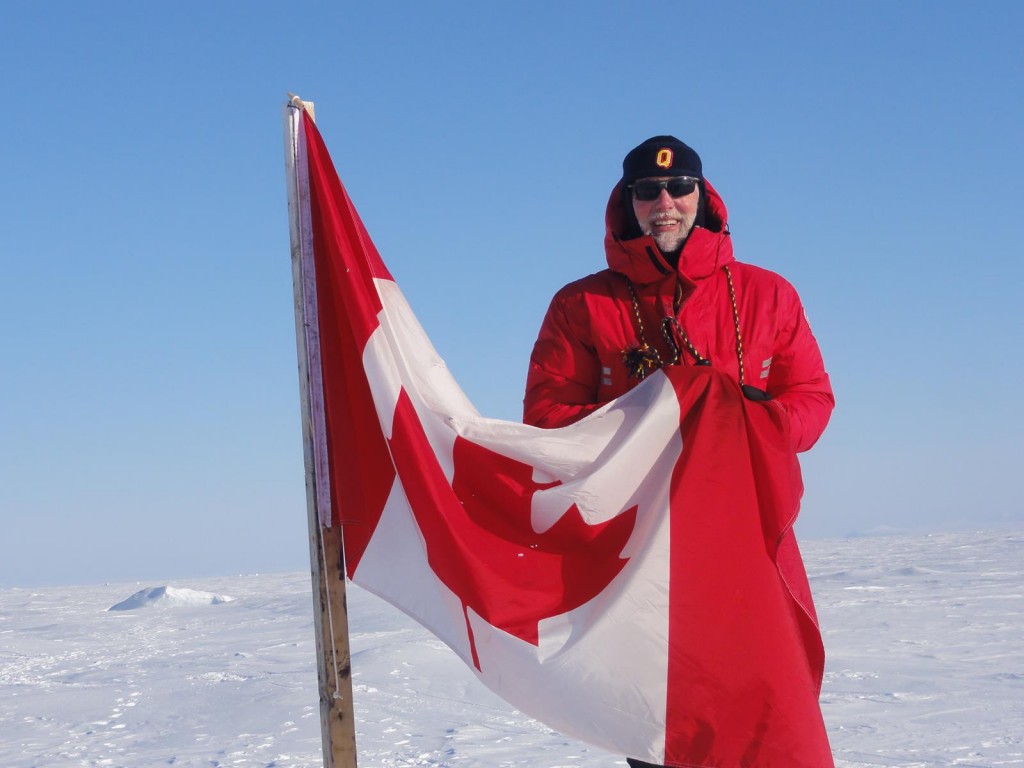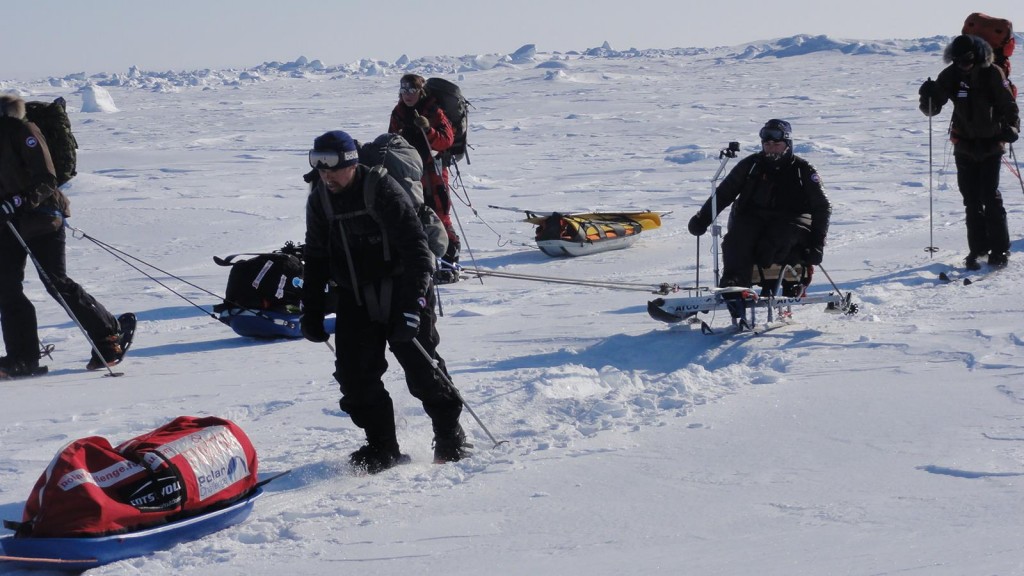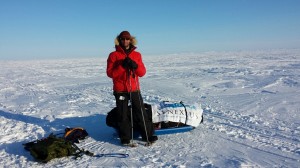
By 7771 Jim Leech
 I returned late last week from our ski expedition to the magnetic North Pole – in one piece but completely bagged. It was a very emotional experience to be a part of the largest such arctic expedition in history – 53 business leaders, veterans, Olympians, expert guides and embedded media (plus Diamon our Austrian Shepherd dog)!
I returned late last week from our ski expedition to the magnetic North Pole – in one piece but completely bagged. It was a very emotional experience to be a part of the largest such arctic expedition in history – 53 business leaders, veterans, Olympians, expert guides and embedded media (plus Diamon our Austrian Shepherd dog)!
I want to thank all of you who supported us (both financial and moral support) and our families during that time. By all measures, the expedition was a resounding success – we reached our objective in the face of several adversities, no one was injured and to date we have raised close to $2 million to help our brave, wounded soldiers, particularly those suffering from Post Traumatic Stress Disorder.
For those interested, below is a chronology (from my log as well as others) and a few photos.
Saturday April 19 – We flew seven hours from Ottawa with all of our personal gear to Resolute Bay, with a brief stop in Iqualuit where we were greeted by the Premier of Nunavit. Resolute Bay is a cold wind swept settlement of 200 people on the northern edge of the NorthWest Passage.
of 200 people on the northern edge of the NorthWest Passage.
Sunday April 20 – Monday April 21- We were divided into “pods” of seven to nine – my pod included: Scott Kress (guide), Bruce Rothney (Barclays), David Zimmerman (Greystone), Dr Markus Besemann (Canadian Armed Forces) and Caroline Ouelette and Genevieve Lacasse (captain and goalie from Canada’s Olympic women’s hockey team). We spent most of Sun and Mon sorting out and testing our gear/clothes, tents, skis and toboggans in the frigid cold environs of Resolute. A lot of time was devoted to perfecting the system to propel one of our soldiers, Bjarne Nielson who had lost a leg and much of the use of one arm in combat. “B”, as he is known, would furiously pole as he was pulled on a double sit ski with outriggers to balance. Two other expedition members would have to pull double toboggans. We also had time for some local fun – pick up game of hockey as well as a community feast which included traditional games (skills, strength and throat singing) and some local delicacies – polar bear, seal, caraboo and whale.
Tuesday April 22 – We were scheduled to leave in three groups but the visibility (blowing snow) in both Resolute and at our destination (King Christian Island) was below flying limits. So, right from the beginning, we had lost our “buffer” day!!
Wednesday April 23 – Two pods got out in the morning (it is a two hour flight north to King Christian Island). My pod was loaded into a twin otter around noon and all set to leave when there was a change in plan. We reloaded all of our gear into an 18 passenger Basler (a rebuilt DC 3 from 1943!), taxied out to the airstrip and revved the engines at which time the pilot called it off due to the weather. So the two pods on the ice had to hunker down for the night and hope we could join them the next morning. The rest of us went back to the hotel/barracks to watch hockey/basketball.
Thursday April 24 – The weather was perfect and our pod got out early in the morning via the Basler. Landing on the ice felt very similar to a water landing as you bounced up and down on the snow. There is a brief moment after all your gear is unloaded, the DC 3 has roared away and you are left in silence thinking: I have just been dropped on the ice, 200 kms north of no where, and expected to ski another 100 kms further north – what have I got myself into!!?? But there is not much time to worry as we had to set up our camp (tents and build latrine) to wait for the final two pods to arrive four hours later.
The original plan was to ski only one hour on the first day once the other pods arrived (a sort of “shake out”) but as we were already one day behind schedule, we had to make up time. So we skied well into a sun filled evening that first day, doing 16 km across “good” wind blown sea ice (relatively flat with no ridges) with each of us pulling sleds filled with our kit, food and tents. It was cold and blowing so everyone wore googles and masks. Setting up camp that first evening was particularly cold. The temperature generally hovered around -20 to -25 degrees throughout most of the trip. Whether you felt cold or not depended on the wind, sun and how much energy you were expending. I normally wore one or two layers beneath my Helly Hansen yellow shell while skiing (one day I was able to go without the shell jacket), but within seconds of stopping you would freeze and had to put on your parka. The challenge was to wear just enough clothing to ski slightly cold in order not to sweat and freeze the moment you stopped or the wind picked up.
Friday April 25 – Our days started at 7 am (when the Diamon sounded a barking alarm) in a cold tent with lots of frozen condensation. It was tough getting out of our sleeping bags to put them outside to dry in the sun and wind. Two hours was spent melting water to hydrate and eat some hot oatmeal – spiced with honey, maple syrup and/or cinnamon). Just after 10 am we were on our skis moving north.
This day the ice was refrozen pack ice that was very “rough” – many ridges and “ice sculptures” that you had to navigate. Our routine was: ski 30 minutes and then stop for 5 minutes to adjust clothing (de-layer normally), ski three 1.5 hour legs with a 10min break between legs, and then a final 1.5 hours before setting up camp. In total, we covered 16 kms. Our lunch/snacks during the day consisted of frozen chocolate bars, truffles, deep fried bacon, fruit cake, nuts and dried meats which were at best cold, but mostly still frozen. You had to plan the breaks carefully: removing your back pack and fetching your parka (then reversing the process before you resumed skiing) basically used up four minutes; that left you six minutes to: pee, get a drink, eat and adjust your gear – impossible to do everything so you had to prioritize!
From the very start we were pretty efficient at setting up camp – expedition tents held up by skis and poles for cooking and sleeping up to five people (everyone in my tent was over 6′ 2”!!) and a smaller two person tent just to sleep in (Gen and Caro smartly commandeered our smaller tent). We would use snow saws to make walled latrines (with raised seats) to keep us out of the wind when nature called as well as wind walls to protect the sleeping tents. After about 15 minutes of melting water the expedition tents started to warm up and we peeled off some layers – usually down to long undies. First thing was a Weber cocktail (milk powder, maple syrup and whiskey) to celebrate the day (I had brought a bottle of champagne that we enjoyed the first night as well – with one exception, I had been “dry”for four months leading up to the expedition!) and crackers with frozen cheese and pate while boiling more water for dinner. Dinners were dehydrated meals in a bag that were actually quite yummy (sweet/sour pork with rice, beef stroganoff, etc). Evenings were full of life stories and humour while the sun continued to shine brightly. Every night it was very tough to turn off the stoves – one of the biggest risks in arctic camping is burning your tent or sleeping bag (there were no spares!) – get everything and everyone out before bringing in our cold sleeping gear from our sleds.
I think the earliest we got to bed on the ice was 11:30 pm. You had to wear eye masks to block the light, a balaclava to stop your nose from freezing and ear plugs to down out the inevitable snoring. Anything you want to prevent from freezing went in your sleeping bag with you eg jar of peanut butter, water, camera, the next days’ socks and undies, etc. And of course a pee bottle in your bag was a requirement; you do not want to crawl outside in the middle of the night (works well if you are a contortionist but do not confuse with your water bottle). In the morning there is all kinds of frost around your sleeping bag breathing hole.
Saturday April 26 – Basically the same routine over the same rough terrain except this time we skied for eight hours and covered 21 kms – we had made up the lost day up front! Our group was so large that between the first and the last person there could often be a two kilometres; that was ok as long as the visibility was good. We were blessed with several days and nights of sunshine although the wind could change moment to moment – the expedition found a good rhythm and each of us learned to manage the cold and the long days.
We camped that night on the southern shore of Ellef Ringes Island. That evening, we learned that a storm was expected on Tuesday, the day we were expected to arrive at the pole. A decision was made to accelerate our pace and cover the last three days of travel in two days which meant skiing for eight to nine hours for the next two days.
Sunday April 27 – We crossed Ellef Ringnes Island by following a beautiful river valley system. We skied 21 kms over eight hours, mostly uphill protected from any wind and heated by the sun – many of us stripped down to one base layer of clothing. It felt as though you could ski forever up this winding valley overlooked by the occasional snow swept rock formation. We saw lemming, arctic fox and fresh polar bear tracks including bum print where a bear slid down a hill. Near the end of the day there were some short downhill sections – we were all so tired that it was not a pretty sight watching us descend on skis chased by our toboggans! Camp that night was near the top of the valley well protected from wind. A few of our group even dug snow caves or lean-tos’ and slept outside.
Monday April 28 – The last day of skiing was a big push to get to pole before the storm hit later that night or the next day. We covered the final 5 kms on Ellef Ringes Island and then back onto the ice for an additional 18 kms. It was a very long haul but we finally reached the magnetic pole around 8pm (100 kms by the crow, 120 kms actual distance traveled). We were all exhausted, but also elated. The group in front stopped 200 metres short so that we could all move en masse to the pole, led by our soldier contingent. I changed into my Santa outfit for the occasion! The Arctic Rangers had been thoughtful enough to plant a Canadian flag at the pole so we all gathered around for photos and proudly sang O Canada at the top of our voices, in French and English. It was a very emotional moment and an opportunity to pay tribute to those who had fallen as well as those who are forever changed.
It was now 9 pm – the temperature was dropping fast and the wind was picking up – so we put up our tents and surrounded them with higher than usual snow walls to protect us from the wind. After dinner, our guides distributed private letters to us from our families and friends – there was not a dry eye in our tent as we savoured the love and best wishes from our families. We concluded the day with a reading of “The Cremation of Sam McGee” by Robert Service and then turned in at 0100 am.
 Tuesday April 29 – The storm arrived in the middle of the night – blowing snow and lousy visibility – everything is white. You could see how someone might get lost walking to the latrine. We slept until 11:00 am and were very happy just to stay inside our tents as the temperatures and the visibility dropped while the storm swirled around us. We were lucky to have built some well protected latrines because the wind chill was brutal. By this point, we were tired of eating the same thing every day so started the day by frying up some of the previously deep fried bacon that we served on warmed dehydrated pitas and some leftover cheese… bacon pizza.
Tuesday April 29 – The storm arrived in the middle of the night – blowing snow and lousy visibility – everything is white. You could see how someone might get lost walking to the latrine. We slept until 11:00 am and were very happy just to stay inside our tents as the temperatures and the visibility dropped while the storm swirled around us. We were lucky to have built some well protected latrines because the wind chill was brutal. By this point, we were tired of eating the same thing every day so started the day by frying up some of the previously deep fried bacon that we served on warmed dehydrated pitas and some leftover cheese… bacon pizza.
We spent the day resting, reinforcing our snow walls, building an igloo, socializing between tents (my sour jube jubes were really popular) and blasting a few snowmen with our shotguns.
Wednesday April 29 – The weather cleared so we were pretty sure we would get out. We had a bacon pizza breakfast, but this time outside our tents. By 10:00 am we saw the twin Otters approaching our earmarked landing strip – shouts of “The plane! The plane!”. The Otters were followed by two round trips from the Basler DC 3 starting at 1:30 pm. By 8pm we were all back in Resolute showered and celebrating with some champagne, wine and beer (Resolute is a “dry” community but we had been given a special liquor license).
Thursday April 30 – All the gear was sorted by morning and we all flew back to Ottawa and then on to Toronto/Montreal.
Observations :
1. The north is vast, harsh, unforgiving but beautiful in its own way. People who live there are a special breed. It takes a long time to do anything!
2. Modern clothing/gear has made a huge difference – I cannot imagine what it would have been like with canvass tents or non technical clothing.
3. Although I did not feel it at the time (and acquitted myself well physically, esp as the oldest, almost 67 year old), I was bagged – recovery took five days.
4. Our group started as executives from Ontario and Quebec, veterans from across the country, a couple Olympic athletes, some hardworking guides and a film crew but ended as one team having formed many deep relationships and friendships.





